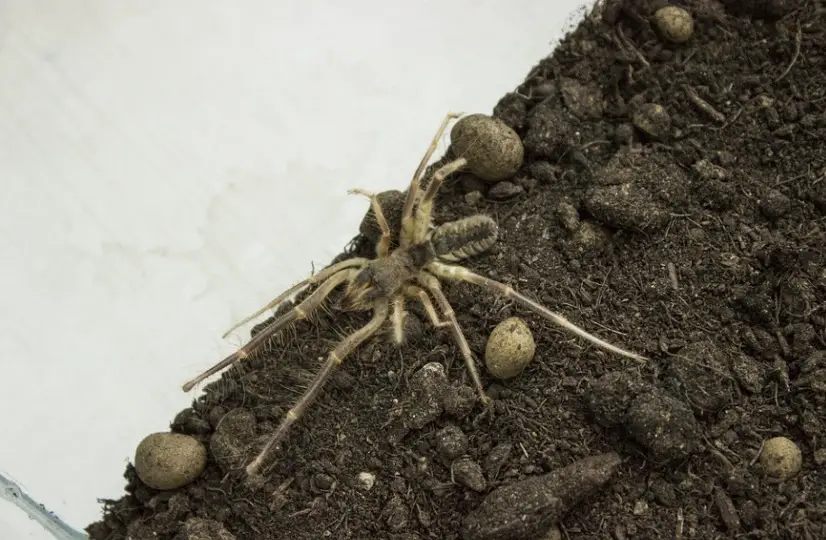Table of Contents
Camel Spiders: All You Need To Know
Camel spiders are arid, roaming predators that belong to the kingdom of Animalia, phylum Arthropoda, and class Arachnida. It has more than 150 genera, and more than 1,000 species. Its length is up to 15 cm, and it weighs about less than 30 g. It lives in the deserts and arid scrubland. Its lifespan is unknown.

What is Camel Spiders?
The camel spider is a common name for many species of the Solifugae order. These animals, sometimes known as wind scorpions or sun spiders, are neither scorpions nor spiders. While they are still classified as arachnids, they have characteristics that are similar to both scorpions and spiders.
The camel spider has a sharply segmented opisthosoma, similar to scorpions. It does not, however, have a stinger on its extended tail. Camel spiders, like spiders, utilise their pedipalps (foremost limbs) to find and manipulate prey. Camel spiders, like other arachnids, have eight legs, but their pedipalps are so enormous that they appear to have ten.
The chelicerae of a camel spider are significantly larger than those of other arachnids, but unlike many spider species, they do not carry venom. Instead, they utilise these strong appendages to rip and tear their prey into little pieces, which are subsequently liquified and ingested.
Camel spiders should not be touched since their chelicerae are strong enough to pierce human skin. They are, however, not quite as menacing or frightening as the internet has made them out to be.
Common Camel Spiders Myth
Until the early 2000s, most people had never heard of the camel spider. Despite the fact that the order Solifugae is found all over the world and that most locations have more than one species of camel spider, these tiny predators were little recognised until troops fighting in the Middle East began sending back photos of “huge” camel spiders.
These arachnids appeared to be many feet in diameter because they were held closer to the camera. Camel spiders are virtually totally safe to humans, reaching a maximum size of around 6 inches in circumference. These predators occasionally follow the shadows of bigger animals in the desert, creating the impression that they are following or preying on a camel or human. This, however, is just incorrect.
Camel spiders are said to be toxic, deadly, exceedingly big, aggressive, and quick, among other misconceptions. The camel spider is neither the quickest nor the most deadly bug that humanity has yet encountered. In fact, most people were unaware that camel spiders existed until online rumours and doctored photos circulated.
Fun Facts About Camel Spiders!
Though the camel spider has been the stuff of many people’s nightmares for the past decade or two, it was largely unknown before then. The camel spider, far from being a hideous horror, is a wonderful example of the following biological ideas!
Chelicerae + Pedipalps
The chelicerae and pedipalps, which may be observed on a camel spider, are two arachnid-specific appendages. Chelicerae are pinching appendages with sharp articles that may or may not have small teeth. These pinchers have the ability to grasp, tear, and cut through prey.
Although scorpion chelicerae are longer, they are not nearly as strong as camel spider chelicerae. Camel spiders may also stridulate, which is a hissing or chattering sound produced by rubbing stiff sections of the chelicerae together. Solifugae members have pedipalps, which are leg-like appendages that are not utilised for locomotion, similar to spiders and scorpions.
Instead, these prominent appendages are devoted exclusively to the task of locating, catching, and manipulating prey. Small hairs cover the pedipalps, allowing a camel spider to sense whatever the pedipalps contact.
Fear of Arachnids
Interestingly, many primate species, not just humans, have an innate dread of arachnids. Animals have evolved to dread or avoid species that are potentially harmful. However, because there are millions of species on the planet, animals must generalise which characteristics they use to identify a potentially harmful species.
Because some eight-legged species have the ability to harm humans, most people develop a phobia of all crawling insects. Despite the fact that this fear is illogical in the instance of the camel spider, it is entrenched in many cultures and communities. Though evolutionary dread may have helped our forefathers survive and reproduce in the past, current science has made it simple to differentiate hazardous animals.
Most humans are afraid of insects, arachnids, and other arthropods because of a deeply ingrained evolutionary response, similar to how a cat reacts to a cucumber as if it were a snake. When you learn more about camel spiders, you’ll find that they’re not a danger, but rather an extraordinary group of species with incredible adaptations.
Camel Spiders Citations
- Functional morphology and bite performance of raptorial chelicerae of camel spiders (Solifugae). J Exp Biol . 2012 Oct 1;215(Pt 19):3411-8.
- Morphology of the tracheal system of camel spiders (Chelicerata: Solifugae) based on micro-CT and 3D-reconstruction in exemplar species from three families. Arthropod Struct Dev . 2016 Sep;45(5):440-451.
- Primary processing neuropils associated with the malleoli of camel spiders (Arachnida, Solifugae): a re-evaluation of axonal pathways. Zoological Lett . 2019 Aug 2;5:26.
- An annotated type catalogue of the camel spiders (Arachnida: Solifugae) held in the Zoological Museum Hamburg. Zootaxa . 2018 Jan 23;4375(1):1-58.







